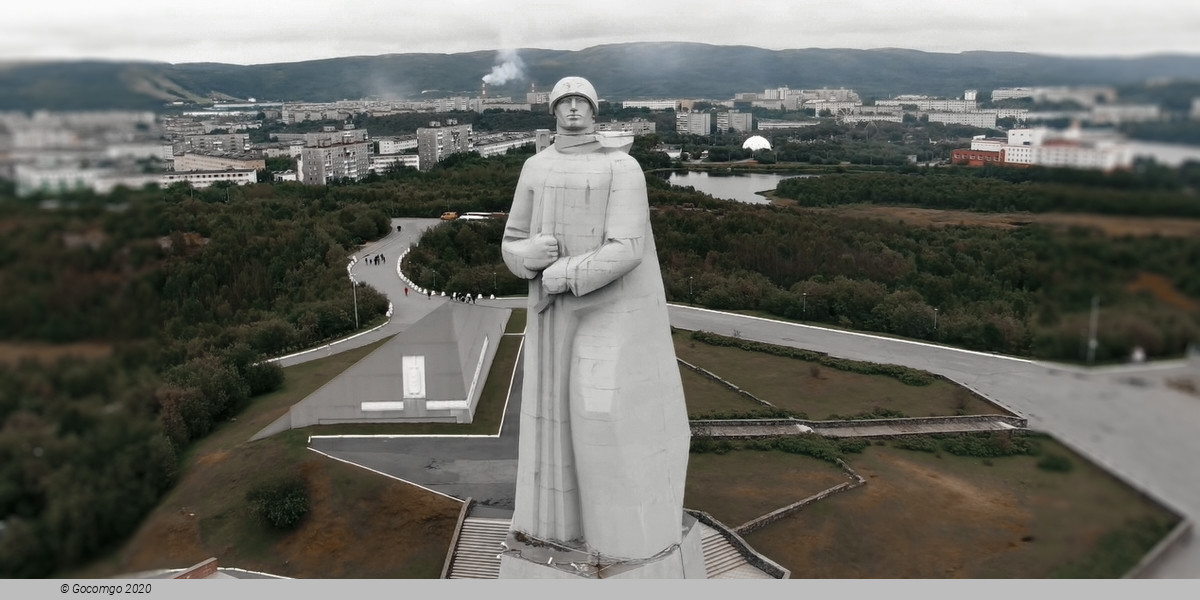Murmansk

Murmansk is a port city and the administrative center of Murmansk Oblast in the far northwest part of Russia. It sits on both slopes and banks of a modest ria or fjord, Kola Bay, an estuarine inlet of the Barents Sea. Its bulk is on the east bank of the inlet. It is in the north of the rounded Kola Peninsula which covers most of the oblast. The city is 108 kilometers (67 mi) from the border with Norway and 182 kilometers (113 mi) from the Finnish border. The city is named for the Murman Coast, which is in turn derived from an archaic term in Russian for "Norwegian".
History
Murmansk was the last city founded in the Russian Empire. In 1915, World War I needs leading to the construction of the railroad from Petrozavodsk to an ice-free location on the Murman Coast in the Russian Arctic, to which Russia's allies shipped military supplies. The terminus became known as the Murman station and soon boasted a port, a naval base, and an adjacent settlement with a population that quickly grew in size and soon surpassed the nearby towns of Alexandrovsk and Kola.
On June 29 [O.S. July 12], 1916, Russian Transport Minister Alexander Trepov petitioned to grant urban status to the railway settlement.On July 6 [O.S. July 19], 1916, the petition was approved and the town was named Romanov-on-Murman (Рома́нов-на-Му́рмане, Romanov-na-Murmane), after the imperial Russian dynasty of Romanovs. On September 21 [O.S. October 4], 1916, the official ceremony was performed, and the date is now considered the official date of the city's foundation. After the February Revolution of 1917, on April 3 [O.S. April 16], 1917, the town was given its present name.
In the winter of 1917, the British North Russia Squadron under Rear Admiral Thomas Kemp was established at Murmansk.
From 1918 to 1920, during the Russian Civil War, the town was occupied by the Western powers, who had been allied in World War I, and by the White Army forces.
On February 13, 1926, local self-government was organized in Murmansk for the first time, during a plenary session of the Murmansk City Soviet, which elected a Presidium. Before this, the city was governed by the authorities of Alexandrovsky Uyezd and later of Murmansk Governorate. On August 1, 1927, the All-Russian Central Executive Committee (VTsIK) issued two resolutions: "On the Establishment of Leningrad Oblast" and "On the Borders and Composition of the Okrugs of Leningrad Oblast", which transformed Murmansk Governorate into Murmansk Okrug within Leningrad Oblast and made Murmansk the administrative center of Murmansk Okrug.
In 1934, the Murmansk Okrug Executive Committee developed a redistricting proposal, which included a plan to enlarge the city by merging the surrounding territories in the north, south, and west into Murmansk. While this plan was not confirmed by the Leningrad Oblast Executive Committee, in 1935–1937 several rural localities of Kolsky and Polyarny Districts were merged into Murmansk anyway.
According to the Presidium of the Leningrad Oblast Executive Committee resolution of February 26, 1935, the administrative center of Polyarny District was moved from Polyarnoye to Sayda-Guba. However, the provisions of the resolution were not fully implemented, and due to military construction in Polyarnoye, the administrative center was instead moved to Murmansk at the beginning of 1935. In addition to being the administrative center of Murmansk Okrug, Murmansk continued to serve as the administrative center of Polyarny District until September 11, 1938. On February 10, 1938, when the VTsIK adopted a Resolution changing the administrative-territorial structure of Murmansk Okrug, the city of Murmansk became a separate administrative division of the okrug, equal in status to that of the districts. This status was retained when Murmansk Okrug was transformed into Murmansk Oblast on May 28, 1938. The Germans were promised the use of the port, which they called Norwegenhafen for transportation of goods and raw materials from 1922 to 1941.
During World War II, Murmansk was a link to the Western world for the Soviet Union with large quantities of goods imported to the respective military efforts traded with the Allies: primarily seeing military equipment, manufactured goods, and raw materials brought into the Soviet Union. The supplies were brought to the city in the Arctic convoys.
German forces in Finnish territory launched an offensive against the city in 1941 as part of Operation Silver Fox. Murmansk suffered extensive destruction, the magnitude of which was rivaled only by the destruction of Leningrad and Stalingrad. However, fierce Soviet resistance and harsh local weather conditions with the bad terrain prevented the Germans from capturing the city and cutting off the vital Karelian railway line and the ice-free harbor.
For the rest of the war, Murmansk served as a transit point for weapons and other supplies entering the Soviet Union from other Allied nations. This resistance was commemorated at the 40th anniversary of the victory over the Germans in the formal designation of Murmansk as a Hero City on May 6, 1985. During the Cold War, Murmansk was the center of Soviet submarine and icebreaker activity. After the dissolution of the Soviet Union, the nearby city and naval base of Severomorsk remains the headquarters of the Russian Northern Fleet.
In 1974, a massive 35.5-meter (116 ft) tall statue Alyosha, depicting a Russian World War II soldier, was installed on a 7-meter (23 ft) high foundation. In 1984, the Hotel Arctic, now known as Azimut Hotel Murmansk, opened and became the tallest building above the Arctic Circle.
On January 1, 2015, the territory of Murmansk was expanded when the urban-type settlement of Roslyakovo, previously under the jurisdiction of the closed administrative-territorial formation of Severomorsk, was abolished and its territory merged into Murmansk.

